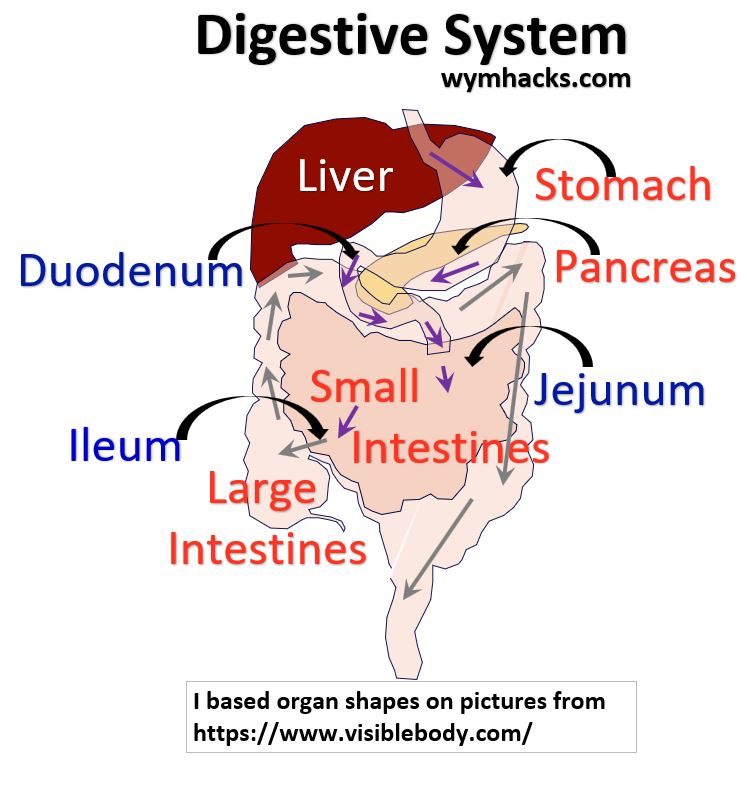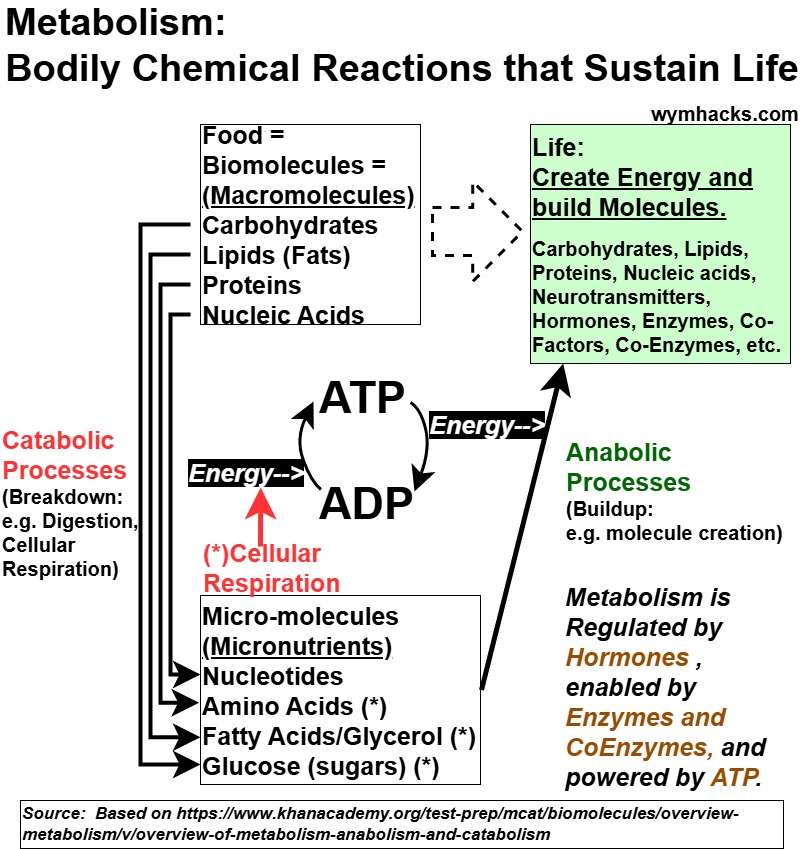Menu (linked Index)
Metabolism Defined
Last Update: October 26, 2024
Introduction
Metabolism involves the bodily chemical reactions that sustain life.
In this post we’ll define human Metabolism in the context of the breaking down of nutrients (Catabolism), energy production (Cellular Respiration), and molecule building (Anabolism).
I’d recommend that you not just read this short article but also review the two videos below.
Introduction to metabolism (anabolism and catabolism) – Khanacadeymy.org
Overview of metabolism: Anabolism and catabolism – Khanacademy.org
You should probably also know a little about Enzymes and Hormones. Review the two references below.
Metabolism Defined
Metabolism can be broadly defined as “chemical reactions that occur in the body that support/sustain/maintain life”.
We eat food and our Gastro Intestinal (GI) Tract breaks it down and utilizes the micro-components in various ways.
- Proteins, Carbohydrates, Fats, and Nucleic Acids (macromolecules) in the food we eat are digested in the mouth, stomach, and the small intestines with the assistance of various enzymes.
- The Stomach also produces the hormone Ghrelin which tells the brain it’s time to eat (It’s a Satiety activator along with Leptin which is produced by our Adipose (fat) tissue).
- The large intestine mainly removes water and makes stool.
Picture_Digestive System (Gastro-Intestinal Tract)

Through digestion with the help of various enzymes, food macromolecules are broken down into their associated micronutrients.
Imagine the micronutrients as Lego building blocks that are used by the body to provide sufficient energy and build the needed molecules to keep us alive.
The “breaking down” process is called Catabolism.
- Carbohydrates break down (catabolized) into various sugars with Glucose being the primary one.
- Lipids (Fats) primarily catabolize to Glycerol and Fatty Acids.
- Proteins catabolize to Amino Acids
- Nucleic Acids (from meats for example) catabolize to Nucleotides
See my post on macro/micro nutrients to view the structures of these molecules.
The “building up” process is called Anabolism. Some examples of Anabolism are
- Protein synthesis for muscle and tissue growth and repair, enzymes, and hormones.
- Glucose conversion to Glycogen
- Fat Production
Big Picture
So, how do these Catabolic and Anabolic chemical reactions fit and work together overall?
The high level schematic below summarizes this nicely (I think). It’s based on this excellent khanacademy video.
Picture_Metabolism – The Chemical Reactions that Sustain Life

Summarizing the Picture Above (see Intro to Metabolism, Anabolism, Catabolism – www.khanacademy.org):
- Our body catabolizes the food we eat into various micronutrients.
- Cellular Respiration breaks down Glucose (and other nutrients depending on the current “state” of the body) to produce energy.
- Cellular Respiration: C₆H₁₂O₆ (glucose) + 6 O₂ (oxygen) = 6 CO₂ (carbon dioxide) + 6 H₂O (water) + ATP (containing readily usable energy)
- Oxygen is needed (although anaerobic routes also occur to a lesser degree). Carbon dioxide ,water, and the molecule ATP are created.
- Cellular Respiration provides the energy needed to create ATP in a reaction called Phosphorylation (the enzyme ATP Synthase enables this to happen).
- ATP (Adenosine Tri-Phosphate), enabled by various enzymes, can release a phosphate group, release energy, and convert to ADP (Adenosine Di-Phosphate).
- This released energy is used to power cellular processes (both in anabolic and catabolic processes).
- And the cycle continues, with ATP being produced from ADP via cellular respiration etc..
- This cycle keeps you alive. Be amazed.
For more on Cellular Respiration check out my series of posts on this topic:
Conclusion
In this post we generally described the concept of human Metabolism as the
- breakup (Catabolism) of nutrients,
- the generation of energy (Cellular Respiration), and
- the buildup of molecules (Anabolism).
Learning these processes and their interdependence and interconnectedness is key to understanding how our bodies function.
Disclaimer: The content of this article is intended for general informational and recreational purposes only and is not a substitute for professional “advice”. We are not responsible for your decisions and actions. Refer to our Disclaimer Page.
